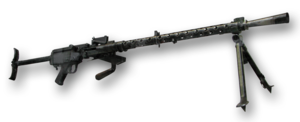$1900 shipped, non-gun, ships direct to you. This is a German WWII MG 13 display gun. It has been de-activated to ATF specs, with the chamber welded shut. Many usable parts to restore to working condition, follow the NFA rules. Included are 10 magazines with an around the neck ammo carrier. Folding bipod, folding stock, collapsible butt plate with leather pads, all in good shape. 10 magazines are included.
The MG 13 was introduced into service in 1930, where it served as the standard light machine gun until 1935.[1] It was superseded by the MG 34 and then later the MG 42. An unusual feature of the MG 13 was its double-crescent trigger, which provided select fire capability without the need for a fire mode selector switch. Pressing the upper segment of the trigger produced semi-automatic fire, while holding the lower segment of the trigger produced fully automatic fire. It also fired from a closed bolt. MG 13s were sold to Spain where they retained the designation of MG13 and to Portugal which used them into the late 1940s as the Metralhadora 7,92 mm m/1938 Dreyse.[1] Those MG 13's that were not sold but rather were placed into storage later saw use in World War II by second line German units. As it was easy to handle and reload, many second line troops could use the MG 13 with efficiency. On later examples a 75-round saddle drum was also used. It was equipped with a folding butt stock and a carrying handle.[2] It was used in the turret of the Panzer I tank.[3









The MG 13 was introduced into service in 1930, where it served as the standard light machine gun until 1935.[1] It was superseded by the MG 34 and then later the MG 42. An unusual feature of the MG 13 was its double-crescent trigger, which provided select fire capability without the need for a fire mode selector switch. Pressing the upper segment of the trigger produced semi-automatic fire, while holding the lower segment of the trigger produced fully automatic fire. It also fired from a closed bolt. MG 13s were sold to Spain where they retained the designation of MG13 and to Portugal which used them into the late 1940s as the Metralhadora 7,92 mm m/1938 Dreyse.[1] Those MG 13's that were not sold but rather were placed into storage later saw use in World War II by second line German units. As it was easy to handle and reload, many second line troops could use the MG 13 with efficiency. On later examples a 75-round saddle drum was also used. It was equipped with a folding butt stock and a carrying handle.[2] It was used in the turret of the Panzer I tank.[3
| MG13 | |
|---|---|
| Service history | |
| Production history | |
| Specifications | |
 Maschinengewehr 13 | |
| Type | Light machine gun |
| Place of origin | Weimar Republic |
| In service | 1930–1945 (Germany) |
| Used by | See Users |
| Wars | Spanish Civil War World War II Second Sino-Japanese War Chinese Civil War Portuguese Colonial War |
| Designed | 1928 |
| Produced | 1930–1934 |
| Mass | 13.3 kg (29 lb) |
| Length | 1,443 mm (56.8 in) |
| Barrel length | 718 mm (28.3 in) |
| Cartridge | 7.92×57mm Mauser |
| Action | Short recoil, fired from closed bolt |
| Rate of fire | 600 rounds/min |
| Muzzle velocity | 890 m/s (2,900 ft/s) |
| Maximum firing range | 2,000 metres (2,200 yd) |
| Feed system | 25 round box magazine, or 75 round saddle drum, 5 round stripper clip |
Last edited:


